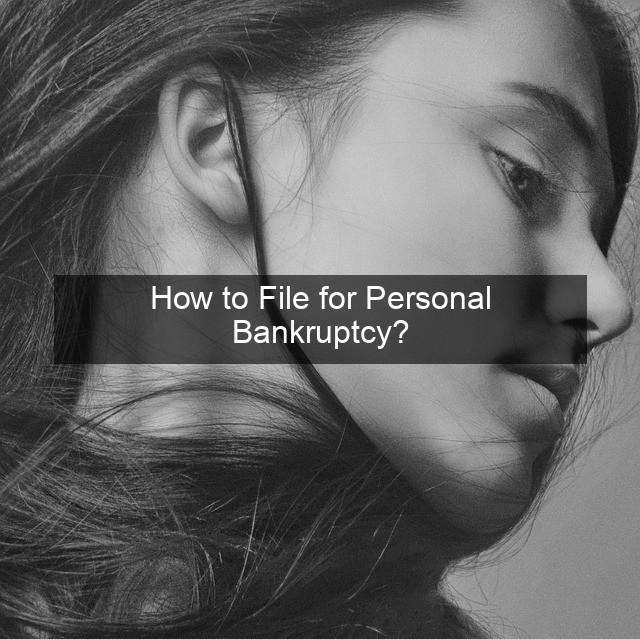How to File for Personal Bankruptcy?

- How to File for Personal Bankruptcy?
- How to File for Personal Bankruptcy?
- Understanding the Types of Bankruptcy
- Chapter 7 Bankruptcy
- Chapter 13 Bankruptcy
- Preparing for Bankruptcy
- Gathering Necessary Documentation
- Seeking Professional Guidance
- The Bankruptcy Process
- Filing the Petition
- Meeting with Creditors
- Life After Bankruptcy
- Frequently Asked Questions (FAQ)

How to File for Personal Bankruptcy?
Drowning in debt can feel overwhelming and isolating. The weight of financial obligations can impact every aspect of your life, from your mental health to your future prospects. While it’s a difficult decision, filing for personal bankruptcy can offer a fresh start and a path towards financial recovery. It’s a legal process designed to provide relief from overwhelming debt, allowing individuals to regain control of their finances and rebuild their lives. This comprehensive guide will walk you through the steps involved in filing for personal bankruptcy, explaining the different types available and what you can expect throughout the process. Understanding the complexities of bankruptcy can empower you to make informed decisions and navigate this challenging period with greater confidence. Personal bankruptcy is not a one-size-fits-all solution, and it’s crucial to understand the implications before proceeding. This guide will provide the knowledge you need to make the best choice for your unique situation. Remember, seeking professional advice from a financial advisor or bankruptcy attorney is highly recommended to ensure you understand the full implications and legal ramifications.
Understanding the Types of Bankruptcy
Chapter 7 Bankruptcy
Chapter 7 bankruptcy, often referred to as liquidation bankruptcy, is the most common type of personal bankruptcy. It involves the liquidation of non-exempt assets to pay off creditors. This means that certain possessions may be sold to generate funds for debt repayment. However, many essential assets, such as a primary residence or vehicle, are often protected under state or federal exemption laws. The process typically takes a few months to complete, and upon discharge, most unsecured debts are eliminated. This can provide a significant financial reprieve for individuals struggling with overwhelming unsecured debt like credit card bills and medical expenses.
The process begins by filing a petition with the bankruptcy court, providing detailed information about your assets, liabilities, and income. A trustee is then appointed to oversee the process and liquidate any non-exempt assets. Creditors are notified of the bankruptcy filing and are prohibited from pursuing collection actions. After the liquidation process, eligible debts are discharged, providing a fresh start for the debtor.
While Chapter 7 offers a relatively quick path to debt relief, it’s important to understand the potential consequences. Filing for bankruptcy can negatively impact your credit score, making it more difficult to obtain loans or credit in the future. It’s crucial to weigh the benefits and drawbacks carefully before deciding if Chapter 7 is the right option for your circumstances.
Chapter 13 Bankruptcy
Chapter 13 bankruptcy, also known as reorganization bankruptcy, offers an alternative approach to debt relief. Instead of liquidating assets, Chapter 13 involves creating a repayment plan to repay creditors over a period of three to five years. This option is often suitable for individuals with a regular income who want to retain their assets while managing their debt. Under Chapter 13, debtors propose a repayment plan to the court, outlining how they will repay a portion or all of their debts within the specified timeframe.

The repayment plan takes into account the debtor’s income, expenses, and the value of their assets. The court must approve the plan, and once approved, the debtor begins making regular payments to the trustee, who then distributes the funds to creditors. Successfully completing the repayment plan results in the discharge of remaining eligible debts. This allows individuals to maintain ownership of their assets while addressing their debt obligations in a structured manner.
Chapter 13 can be a viable option for individuals facing foreclosure or repossession, as it allows them to catch up on missed payments while continuing to make regular payments. It also provides an opportunity to consolidate debts and potentially reduce interest rates, making debt repayment more manageable.
Preparing for Bankruptcy
Gathering Necessary Documentation
Preparing for bankruptcy requires gathering various financial documents to provide a comprehensive overview of your financial situation. These documents typically include tax returns, pay stubs, bank statements, credit card statements, and loan documents. Organizing these records is essential for accurately completing the bankruptcy forms and ensuring a smooth process. It’s advisable to create copies of all documents for your records and to keep them organized in a safe place.
Accurate and complete documentation is crucial for the bankruptcy process. Missing or incomplete information can delay the proceedings and potentially lead to complications. Therefore, it’s recommended to start gathering these documents well in advance of filing for bankruptcy.
Creating a detailed list of all assets and liabilities is also essential. This includes real estate, vehicles, personal belongings, credit card debt, medical bills, and other outstanding loans. A thorough inventory of your assets and liabilities will help you understand your financial standing and make informed decisions throughout the bankruptcy process.
Seeking Professional Guidance
Navigating the complexities of bankruptcy can be challenging, and seeking professional guidance from a qualified bankruptcy attorney or financial advisor is highly recommended. An attorney can provide legal advice tailored to your specific circumstances, ensuring you understand your rights and obligations throughout the process. They can also represent you in court and handle communication with creditors.
A financial advisor can help you assess your financial situation, explore alternative debt management strategies, and develop a budget to manage your finances effectively after bankruptcy. They can also provide guidance on rebuilding your credit and making sound financial decisions in the future.
Consulting with a credit counselor before filing for bankruptcy can also be beneficial. Credit counseling agencies can provide education about budgeting, debt management, and alternative solutions to bankruptcy. They can also help you develop a debt management plan to address your financial challenges.
The Bankruptcy Process
Filing the Petition
The bankruptcy process begins with filing a petition with the bankruptcy court. The petition contains detailed information about your assets, liabilities, income, and expenses. It’s essential to ensure the information provided is accurate and complete, as any discrepancies can delay the process or lead to complications.
After filing the petition, an automatic stay goes into effect, preventing creditors from pursuing collection actions against you. This provides immediate relief from creditor harassment and allows you to focus on the bankruptcy proceedings.
A meeting of creditors, also known as a 341 meeting, is scheduled where creditors have the opportunity to question you under oath about your finances. This meeting is typically presided over by the bankruptcy trustee and provides an opportunity for creditors to clarify any information provided in the bankruptcy petition.
Meeting with Creditors
The meeting of creditors is a crucial part of the bankruptcy process. It provides an opportunity for creditors to ask questions about your finances and verify the information provided in your bankruptcy petition. While it can be intimidating, it’s essential to attend the meeting and answer questions truthfully and accurately.
The trustee will also review your documents and may ask questions about your assets, liabilities, and income. It’s important to cooperate with the trustee and provide any requested information promptly.
The meeting of creditors is typically brief and conducted in a professional manner. While creditors have the right to ask questions, they are not allowed to harass or intimidate you. Having legal representation at the meeting can provide additional support and ensure your rights are protected.
Life After Bankruptcy
While bankruptcy can provide a fresh start, it’s essential to understand that it will have a lasting impact on your credit report. Bankruptcy typically remains on your credit report for seven to ten years, affecting your ability to obtain credit in the future. However, rebuilding your credit is possible with diligent effort and responsible financial management.
Developing a budget and adhering to it is crucial for managing your finances effectively after bankruptcy. Tracking your income and expenses can help you identify areas where you can reduce spending and save money. Creating a realistic budget and sticking to it can help you rebuild your financial stability and avoid falling back into debt.
Building good credit habits is essential for improving your credit score over time. This includes paying bills on time, keeping credit card balances low, and avoiding unnecessary debt. Regularly monitoring your credit report can also help you identify any errors or discrepancies and take corrective action promptly.
Frequently Asked Questions (FAQ)
What are the eligibility requirements for filing for bankruptcy?
There are specific income and debt limits for filing for bankruptcy, which vary depending on the type of bankruptcy and your state of residence.
How will bankruptcy affect my credit score?
Bankruptcy will have a negative impact on your credit score, and it can remain on your credit report for up to ten years.
Can I keep my house and car if I file for bankruptcy?
In many cases, you can keep your house and car if you file for bankruptcy, especially if you are current on your payments and the assets are protected by exemption laws.
How long does the bankruptcy process take?
The bankruptcy process typically takes a few months for Chapter 7 and three to five years for Chapter 13.
What debts can be discharged in bankruptcy?
Many unsecured debts, such as credit card debt and medical bills, can be discharged in bankruptcy. However, certain debts, such as student loans and child support, are typically not dischargeable.




